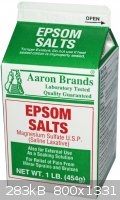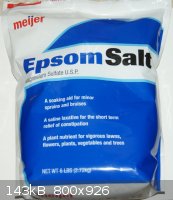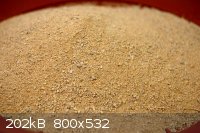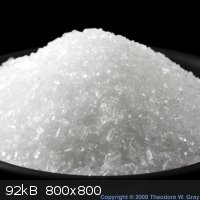Fantasma4500
International Hazard
    
Posts: 1677
Registered: 12-12-2012
Location: Dysrope (aka europe)
Member Is Offline
Mood: dangerously practical
|
|
Dolomite chalk
huge bags for small prices are always interesting, as a chemist i see use in everything.. however...
something i paid abit more attention to --- magnesium
i found some data on what this 'dolomite chalk' contains
DOLOMIT KALK
12% Mg
51% CaCO3
40% MgCO3
as it talks about MgCO3, i suppose Mg isnt the MgCO3?? would this really mean theres magnesium METAL in some sort of mesh or large chunks within it??
as i tried to figure out how to seperate this stuff out i got to H2SO4 as being useful to some extent..
H2SO4 + CaCO3 + MgCO3 > H2O + MgSO4 (aq) + CaSO4 (s) + CO2
~~not balanced, just showing the idea~~
but.. H2SO4 and magnesium metal would be quite a waste.. i really cant come up with an idea to seperate out the magnesium metal from the others..
heating the whole bunch wouldnt give much magnesium im sure, it would simply be stuck in the carbonates
any ideas?
25kg ~3.3 euro --- 3kg Mg, in case it has 12% magnesium metal per weight
|
|
|
bfesser
Resident Wikipedian
    
Posts: 2114
Registered: 29-1-2008
Member Is Offline
Mood: No Mood
|
|
Quote: Originally posted by Antiswat  | | as it talks about MgCO3, i suppose Mg isnt the MgCO3?? would this really mean theres magnesium METAL in some sort of mesh or large chunks within it??
|
No, there is no free metallic magnesium.
[Edited on 2.2.14 by bfesser]
|
|
|
Morgan
International Hazard
    
Posts: 1660
Registered: 28-12-2010
Member Is Offline
Mood: No Mood
|
|
Maybe it's the amount available to plants if it's a fertilizer.
[Edited on 2-2-2014 by Morgan]
|
|
|
Sedit
International Hazard
    
Posts: 1939
Registered: 23-11-2008
Member Is Offline
Mood: Manic Expressive
|
|
Its showing 103% that should be a red flag for you right there.
Knowledge is useless to useless people...
"I see a lot of patterns in our behavior as a nation that parallel a lot of other historical processes. The fall of Rome, the fall of Germany — the
fall of the ruling country, the people who think they can do whatever they want without anybody else's consent. I've seen this story
before."~Maynard James Keenan
|
|
|
Morgan
International Hazard
    
Posts: 1660
Registered: 28-12-2010
Member Is Offline
Mood: No Mood
|
|
Here's a 25 kg bag of 55/30.
http://www.ebay.de/itm/25kg-Dolomitkalk-Dolomit-Rasenkalk-Ga...
Agricultural tidbits perhaps an explanation.
"The quality of agricultural limestone is determined by the chemical makeup of the limestone and how finely the stone is ground. To aid the farmer in
determining the relative value of competing agricultural liming materials, the agricultural extension services of several universities use two rating
systems.[10] Calcium Carbonate Equivalent (CCE) and the Effective Calcium Carbonate Equivalent (ECCE) give a numeric value to the effectiveness of
different liming materials.
The CCE compares the chemistry of a particular quarry's stone with the neutralizing power of pure calcium carbonate. Because each molecule of
magnesium carbonate is lighter than calcium carbonate, limestones containing magnesium carbonate (dolomite) can have a CCE greater than 100
percent.[11]"
http://en.wikipedia.org/wiki/Agricultural_lime#cite_note-11
WHAT IS CALCIUM CARBONATE EQUIVALENT?
http://hubcap.clemson.edu/~blpprt/bobweb/BOBWEB2.HTM
|
|
|
Zyklon-A
International Hazard
    
Posts: 1547
Registered: 26-11-2013
Member Is Offline
Mood: Fluorine radical
|
|
Using it to make MgSO4/CaSO4 would be a waist of sulfuric acid, because CaSO4 is very cheap as is its Mg
counter-part.
|
|
|
Fantasma4500
International Hazard
    
Posts: 1677
Registered: 12-12-2012
Location: Dysrope (aka europe)
Member Is Offline
Mood: dangerously practical
|
|
Typisk analyse:
Calciumcarbonat (CaCO3) 51,0%
Magnesiumcarbonat (MgCO3) 40,0%
Magnesium (Mg) 12,0%
http://www.horticoop.dk/datablade/goedning/azelis-broeste/Do...
'typical analysis'
how it is not 100% is a really good question
about MgSO4, only thing ive seen coming close to it was 'special salt'
as i found the datasheet for this 'special-salt' i realised the special thing about it is that it contains --- Sodium Chloride
i dont even think you can buy magnesium sulfate in my country, i would say using magnesium metal to make magnesium sulfate would be a massive waste
magnesium and calcium would still be possible to extract from this, gypsum is in the matter of fact decently pricey where im at, i recall around .. 10
euro for a kg..?
sulfuric acid you can buy online very cheap if you manage to find one of those suppliers that sells pool chemicals by the kg and not by volume, 50%
'tower acid' is what concentration i recall they sell really cheap
anyhow, bfesser.. how can you be entirely sure it doesnt contain free metallic magnesium? because it says magnesium twice, it shows a chemical formula
where both magnesium, calcium and carbonate is as one, and even 103% by weight
|
|
|
TheChemiKid
Hazard to Others
  
Posts: 493
Registered: 5-8-2013
Location: ̿̿ ̿̿ ̿'̿'̵͇̿̿з=༼ ▀̿̿Ĺ̯̿̿▀̿ ̿ ༽
Member Is Offline
Mood: No Mood
|
|
That adds up to 103%, please correct that.
When the police come
\( * O * )/ ̿̿ ̿̿ ̿'̿'̵͇̿̿з=༼ ▀̿̿Ĺ̯̿̿▀̿ ̿ ༽
|
|
|
Pyro
International Hazard
    
Posts: 1305
Registered: 6-4-2012
Location: Gent, Belgium
Member Is Offline
Mood: No Mood
|
|
I believe it is because Mg and MgCO3 ''overlap''
if Mg is the total amount of magnesium
so you could have 40% MgCO3, and X% MgXX that, combined with CaCO3, contain 12% Mg
Does anybody understand this? I'm having trouble painting the picture.
EDIT: if you isolated Mg metal from the chalk mix in a 100% yield you would have 12g Mg for every 100g of dolomite chalk.
(because there might be MgSO4, Mg(NO3)2, Mg3(PO4)2,... in it as well as MgCO3)
better?
[Edited on 4-2-2014 by Pyro]
all above information is intellectual property of Pyro.  |
|
|
bfesser
Resident Wikipedian
    
Posts: 2114
Registered: 29-1-2008
Member Is Offline
Mood: No Mood
|
|
Lost In Translation / Mystery Solved
<a href="https://en.wikipedia.org/wiki/Dolomite" target="_blank">Dolomite</a> <img src="../scipics/_wiki.png" />
CaMg(CO<sub>3</sub> <sub>2</sub> is 13.181% Mg by mass.
<a href="https://en.wikipedia.org/wiki/Dolostone" target="_blanK">Dolostone</a> <img src="../scipics/_wiki.png" />, a common rock
composed of primarily dolomite, would be slightly less than 13.181 % Mg by mass. Assuming that the contents are powdered dolostone with a purity of
91% dolomite<sup>1</sup>, the product would contain 12 % Mg by mass. <em>Your <a
href="https://en.wikipedia.org/wiki/Agricultural_lime" target="_blank">agricultural lime</a> <img src="../scipics/_wiki.png" />
('dolomit kalk') is</em>—<a href="https://en.wikipedia.org/wiki/Occam's_razor" target="_blank">beyond a reasonable
doubt</a> <img src="../scipics/_wiki.png" />—<em>powdered dolostone in a bag.</em> The remaining 9 % is likely
quartz grains and other minerals commonly present in sedimentary rock, and possibly a little water of hydration. <sub>2</sub> is 13.181% Mg by mass.
<a href="https://en.wikipedia.org/wiki/Dolostone" target="_blanK">Dolostone</a> <img src="../scipics/_wiki.png" />, a common rock
composed of primarily dolomite, would be slightly less than 13.181 % Mg by mass. Assuming that the contents are powdered dolostone with a purity of
91% dolomite<sup>1</sup>, the product would contain 12 % Mg by mass. <em>Your <a
href="https://en.wikipedia.org/wiki/Agricultural_lime" target="_blank">agricultural lime</a> <img src="../scipics/_wiki.png" />
('dolomit kalk') is</em>—<a href="https://en.wikipedia.org/wiki/Occam's_razor" target="_blank">beyond a reasonable
doubt</a> <img src="../scipics/_wiki.png" />—<em>powdered dolostone in a bag.</em> The remaining 9 % is likely
quartz grains and other minerals commonly present in sedimentary rock, and possibly a little water of hydration.
24.3050 g/mol Mg ÷ 184.401 g/mol CaMg(CO<sub>3</sub> <sub>2</sub> × 100 % ≈ 13.181 % Mg by mass <sub>2</sub> × 100 % ≈ 13.181 % Mg by mass
40 % MgCO<sub>3</sub> + 51 % CaCO<sub>3</sub> = 91 % MgCa(CO<sub>3</sub> <sub>2</sub> <sub>2</sub>
91 % CaMg(CO<sub>3</sub> <sub>2</sub> × 13.181 %
Mg = 11.99471 % Mg –(2 s.f.)→ 12 % Mg by mass Nothing turns a profit quite
as easily as open-pit mining a ubiquitous rock, grinding it to a powder, and stuffing it into a bag with a fancy label. <sub>2</sub> × 13.181 %
Mg = 11.99471 % Mg –(2 s.f.)→ 12 % Mg by mass Nothing turns a profit quite
as easily as open-pit mining a ubiquitous rock, grinding it to a powder, and stuffing it into a bag with a fancy label.
<sup>1</sup>Of course, it's not necessarily 91 % dolomite, but 'available' magnesium, calcium, and carbonate in different minerals
including dolomite that neatly add up to 91 % [CaMg(CO<sub>3</sub> <sub>2</sub>] during the crude analysis. The actual minerals that are attributed to the percent dolomite would include dolomite,
calcite (CaCO<sub>3</sub> <sub>2</sub>] during the crude analysis. The actual minerals that are attributed to the percent dolomite would include dolomite,
calcite (CaCO<sub>3</sub> , magnesite (MgCO<sub>3</sub> , magnesite (MgCO<sub>3</sub> , ankerite (Ca(Fe,Mg,Mn)(CO<sub>3</sub> , ankerite (Ca(Fe,Mg,Mn)(CO<sub>3</sub> <sub>2</sub> <sub>2</sub> , etc. , etc.
P.S. <em>Dolomit Kalk</em>, taken to be German/Danish, translates to <em>dolomite lime</em> in English.
<em>Chalk</em> (CaSO<sub>4</sub> is
<em>Kreide</em> in German (<a href="http://books.google.com/books?id=0WRIAAAAMAAJ" target="_blank">ref.</a> <img
src="../scipics/_ext.png" /> is
<em>Kreide</em> in German (<a href="http://books.google.com/books?id=0WRIAAAAMAAJ" target="_blank">ref.</a> <img
src="../scipics/_ext.png" /> and <em>Kridt</em> in Danish. and <em>Kridt</em> in Danish.
[Edited on 5.2.14 by bfesser]
|
|
|
testimento
Hazard to Others
  
Posts: 351
Registered: 10-6-2013
Member Is Offline
Mood: No Mood
|
|
Some substances may come cheap, but the process of purification may become a really expensive or tedious job.
|
|
|
Fantasma4500
International Hazard
    
Posts: 1677
Registered: 12-12-2012
Location: Dysrope (aka europe)
Member Is Offline
Mood: dangerously practical
|
|
http://www.ebay.de/itm/2-x-28-Kg-pH-Senker-Minus-Fluessig-Ve...
might come cheap, but imagine the amounts of MgSO4 you would get from it, the amounts might be slightly impure, but we all gotta have some goal with
our everyday lives
its alot of H2SO4, its legit ''bulk'' and with the prices in my country for stuff thats seen as average chemicals equal to table salt.. whew.. its
near that it would be cheaper to buy 10L H2SO4 and 25kg dolomite LIME rather than trying to spend a second to find magnesium sulfate within borders
but as bfesser says, it may sound cheap to us, but it was even cheaper to mine, and even cheaper to mine, powder and label, otherwise they wouldnt
sell it, they still manage to drag profit from it
the reason i didnt perfectly translate it was because i just copypasted the section from the datasheet showing what it contains, my bad not
translating it into lime but rather chalk
i still dont know how there can be more than there is, assuming % is by weight, that would mean theres 750g extra (3%) ?? if 25kg is 100%
|
|
|
bfesser
Resident Wikipedian
    
Posts: 2114
Registered: 29-1-2008
Member Is Offline
Mood: No Mood
|
|
<strong>Antiswat</strong>, MgSO<sub>4</sub> as <a href="https://en.wikipedia.org/wiki/Magnesium_sulfate#Medical"
target="_blank">epsom salt</a> <img src="../scipics/_wiki.png" /> is likely easy to find and cheap, even in Denmark. Your local
pharmacy should carry it in packages resembling American milk cartons or sometimes plastic bags. Epsom salt generally refers to the heptahydrate, but
the last sample I analyzed was 37.9 % H<sub>2</sub>O by mass, which (assuming homogeneity) indicated the tetrahydrate,
MgSO<sub>4</sub> · 4 H<sub>2</sub>O.
 
As for the "typical analysis," I thought I demonstrated it quite clearly, but evidently not clearly enough. Allow me to elaborate:
On many such products, especially agricultural fertilizers, the percents are given as <em>parts out of the whole</em>. When they list 12
% Mg, they mean that 12% <em>of the total mass of the contents</em> of the bag was determined to be magnesium. Likewise, 40 %
<em>of the total mass</em> is presumed MgCO<sub>3</sub> and 51 % <em>of the total mass</em>
CaCO<sub>3</sub>. Because each identified component is measured in percent mass of the whole, <em>the percentages are not
additive.</em> It's a bit different from a standard elemental analysis.
25 kg <em>dolomit kalk</em> × 12 % Mg (by mass) = 3 kg Mg (by mass)
25 kg <em>dolomit kalk</em> × 40 % MgCO<sub>3</sub> (by mass) = 10 kg MgCO<sub>3</sub> (by mass)
25 kg <em>dolomit kalk</em> × 51 % CaCO<sub>3</sub> (by mass) = 12.75 –(2 s.f.)→ 13 kg
CaCO<sub>3</sub> (by mass)
25 kg <em>dolomit kalk</em> × 9 % impurities = 2.3 kg waste (likely insoluble in
H<sub>2</sub>SO<sub>4</sub>
So, a 25 kg bag of <em>dolomit kalk</em> would contain approximately 3 kg magnesium (bound up in dolomite and other minerals), ca. 10 kg
of material that acts like magnesium carbonate (<em>the 3 kg Mg is part of this</em> , and ca. 13 kg of material that acts like calcium carbonate during the crude chemical analysis and use as a
fertilizer. I can't think of a clearer way of explaining this; so if you're still having difficulty, perhaps someone else would be kind enough to
provide a simpler perspective. , and ca. 13 kg of material that acts like calcium carbonate during the crude chemical analysis and use as a
fertilizer. I can't think of a clearer way of explaining this; so if you're still having difficulty, perhaps someone else would be kind enough to
provide a simpler perspective.
If you're hoping to extract the magnesium from <em>dolomit kalk</em> as magnesium sulfate, keep in mind that the separation will be time
consuming and tedious. The source dolostone would undoubtedly contain a small proportion of clay minerals in that other 9 %, which are a real pain in
the ass to filter. Prolonged settling (hours–days) followed by careful decanting through a large filter would be necessary. Also, quartz
grains (another part of that 9 %) will easily scratch borosilicate glassware, and inflict permanent surface damage to porcelain mortars &
pestles—I know this from experience. Below are photos of samples of both <em>dolomit kalk</em> and epsom salt, respectively. I
know which I'd rather purify...
 
[edit] A few related calcualtions:
CaMg(CO<sub>3</sub> <sub>2</sub> + 2
H<sub>2</sub>SO<sub>4</sub>(aq) → CaSO<sub>4</sub>(aq) + MgSO<sub>4</sub>(aq) + 2
H<sub>2</sub>O + 2 CO<sub>2</sub>(g) <sub>2</sub> + 2
H<sub>2</sub>SO<sub>4</sub>(aq) → CaSO<sub>4</sub>(aq) + MgSO<sub>4</sub>(aq) + 2
H<sub>2</sub>O + 2 CO<sub>2</sub>(g)
44.0095 g/mol CO<sub>2</sub> ÷ 60.01 g/mol CO<sub>3</sub><sup>2-</sup> × 100 % ≈ 73.5 % of
CO<sub>3</sub><sup>2-</sup>(aq), by mass, liberated as CO<sub>2</sub>(g)
60.01 g/mol CO<sub>3</sub><sup>2-</sup> × 2 mol CO<sub>3</sub><sup>2-</sup> / mol
CaMg(CO<sub>3</sub> <sub>2</sub> ÷ 184.401 g/mol
CaMg(CO<sub>3</sub> <sub>2</sub> ÷ 184.401 g/mol
CaMg(CO<sub>3</sub> <sub>2</sub> × 100 % =
CaMg(CO<sub>3</sub> <sub>2</sub> × 100 % =
CaMg(CO<sub>3</sub> <sub>2</sub> is 65.09 %
CO<sub>3</sub><sup>2-</sup>, by mass <sub>2</sub> is 65.09 %
CO<sub>3</sub><sup>2-</sup>, by mass
25 kg <em>dolomit kalk</em> × 91 % CaMg(CO<sub>3</sub> <sub>2</sub> × 65.09 % CO<sub>3</sub><sup>2-</sup> × 73.5 %
CO<sub>2</sub>(g) ≈ 11 kg CO<sub>2</sub>(g) / bag (<em>assuming no other carbonates present!</em> <sub>2</sub> × 65.09 % CO<sub>3</sub><sup>2-</sup> × 73.5 %
CO<sub>2</sub>(g) ≈ 11 kg CO<sub>2</sub>(g) / bag (<em>assuming no other carbonates present!</em>
And if you were to take into account the third oxygen of the carbonate which reacts to form water, you're wasting a hell of a lot of your initial 25
kg. I'd appreciate it if someone double-checked all of my calculations—I must have made at least one error.
[Edited on 7.2.14 by bfesser]
|
|
|
ScienceSquirrel
International Hazard
    
Posts: 1863
Registered: 18-6-2008
Location: Brittany
Member Is Offline
Mood: Dogs are pets but cats are little furry humans with four feet and self determination! 
|
|
I suspect that the extraction of magnesium sulphate from dolomite is easier than bfesser suggests given a cheap source of sulphuric acid.
As a starting point I would add dolomite powder slowly to a 10% excess of 50% suphuric acid.
After it has ceased to effervesce, bring it to the boil and swirl. The calcium sulphate and clays should stick together.
Pour the solution through a sand bed filter and then concentrate and crystallise.
Alum, etc were made by similar methods historically so it should work.
But it is a tough approach to Epsom salts.
If you cannot buy Epsom salts, have a look at magnesium carbonate. Cheap as chips and used as gymnastic chalk, etc. Dissolve in sulphuric acid, which
you have, and crystallise.
|
|
|
Fantasma4500
International Hazard
    
Posts: 1677
Registered: 12-12-2012
Location: Dysrope (aka europe)
Member Is Offline
Mood: dangerously practical
|
|
not a single problem, my mind passed that thought on, i had it but i didnt keep it.. i see now.. impurities is the last 9% (:
i get your idea, its cleaner and less messy, but its not as bulky, turning something not quite useful into a decently useful pure chemical is my
quest!
i got a 45L glass vial, and i would just stir it once then let it settle, i would need to add small amounts of acid at a time, simply because of the
fact that CO2 is by some considered toxic
it would be more correct to say you cannot live on CO2, its quite alot CO2 infact, i recall having some specific use for CO2.. ohwell..
on a sidenote i googled epsom salt, i only went to one store which has all sorts of healthy stuff -- including laxatives such as erythritol, they
didnt have any, and of all stores they should have it, ive never actually seen it in stores and its actually only those secondary health stores, those
private owned ones you know, not to mention they charge absolutely full price
its not that much having the product, its the process, a cheap process that can give abit experience handling bulk amounts of chemicals
anyhow, sciencesquirrel -- i think that an excess of H2SO4 would be problematic, taking into consideration that CaMg(CO3)2 is insoluble then its
simple to decant off.. H2SO4 is a hell because it makes holes in clothes, and even in yourself if you have it concentrated enough
also, magnesium carbonate?? i thought they used MgO for that stuff??
but letting the whole lot settle is not something thats gonna take alot of effort, just leave it alone and come back later on, scoop it up and let it
evaporate in a large surface glass pan
|
|
|